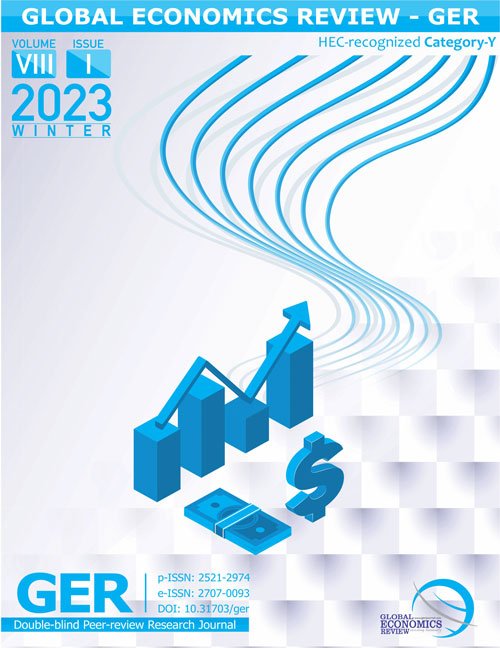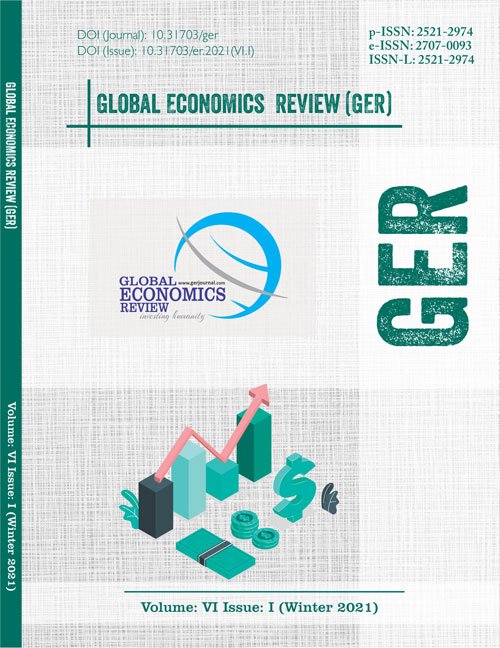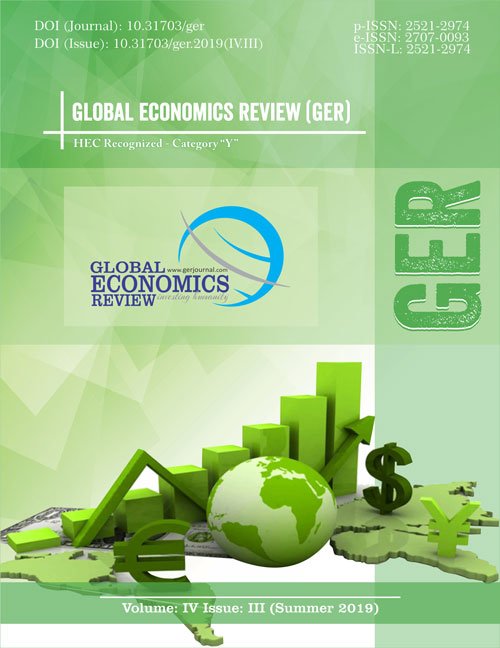01 - Chinese Politico-Economic Engagement in Africa: Strategy of Economic Diplomacy a
http://dx.doi.org/10.31703/ger.2018(III-I).0110.31703/ger.2018(III-I).01 Published : Jun 2018
-
Since the late 1990s, while Chinas official announcement of its going out strategy and soon after, during early 2000s collaborations with World Trade Organization (WTO) to persuade economic engagements beyond Chinese geographical boundaries, expansion of its Foreign Direct Investments (FDI) vis-à-vis trade exploration with both African continents has increased proportionally. Particularly, ... Details
-
Africa, China, Political Economy, Foreign Direct Investment, Non-Interference
-
(1) Assad Mehmood
PhD Scholar,Department of Political Science & International Relations, Qurtuba University of Science & IT Peshawar, KP, Pakistan.
(2) Nazim Rahim
Assistant Professor, Department of Political Science & International Relations, Qurtuba University of Science & IT Peshawar, KP, Pakistan.
(3) Aziz Ur Rehman
Assistant Professor,Department of Political Science & International Relations, Qurtuba University of Science & IT Peshawar, KP, Pakistan.
02 - Institutional Setup in Market Economy and Islamic Property Rights
http://dx.doi.org/10.31703/ger.2018(III-I).0210.31703/ger.2018(III-I).02 Published : Jun 2018
-
This paper argues that there is an ever-growing demand to correlate between Islam and Economics. Property-right and ownership is the basic concept of the modern economic structure of a liberal economic system. A property right is well explained in Islam and that also an essential element for the market economy, this paper discusses the Islamic perspective of property rights and how far it is compl... Details
-
Property-Rights, MarketEconomy, Institutional-Setup, Islam and Economics, EconomicFreedom
-
(1) Noor Fatima
Assistant Professor,Department of International Relations and Political Science, International Islamic University Islamabad, Pakistan.
(2) Muhammad Zubair
Associate Professor, Department of Law,Abdul Wali Khan University Mardan, Mardan, KP, Pakistan.
(3) Zubair Sarfaraz
Legal Consultant, Islamabad,Pakistan.
03 - Problems and Prospects of CPEC for Economic Development and Regional Integration
http://dx.doi.org/10.31703/ger.2018(III-I).0310.31703/ger.2018(III-I).03 Published : Jun 2018
-
China is keenly observing the dynamics of world politics and to meet the challenges of the existing world, China is focusing on economic development and industrialization. China is also trying to facilitate other states to overcome their economic problems by providing them with foreign direct investment, loans, development projects, technical assistance, infrastructure building etc. By doing this,... Details
-
CPEC, Economic Integration, Regional Stability
-
(1) Nazim Rahim
Assistant Professor, Department of Political Science & IR, Qurtuba University of Science & IT, Peshawar, KP, Pakistan.
(2) Assad Mehmmod Khan
PhD. Scholar, Department of Political Science & IR, Qurtuba University of Science & IT, Peshawar, KP, Pakistan.
(3) Muhammad Muzaffar
Assistant Professor, Department of Political Science, Government College Women University Sialkot, Punjab, Pakistan.
04 - European Union and Liberalism
http://dx.doi.org/10.31703/ger.2018(III-I).0410.31703/ger.2018(III-I).04 Published : Jun 2018
-
Complex interdependence is the crucial concept of liberalism. If Liberalism believes in democracy, cooperation, mutual benefits, and human rights, then complex interdependence helps the states to achieve these ideals. Moreover, it also minimizes the chances of conflict and war. The military’s role as a tool of foreign policy is limited, and transnational actors take precedence. The core of l... Details
-
Democracy, Complexinterdependence, Human rights, Cooperation, Mediation, Military Control
-
(1) Sohail Ahmad
Assistant Professor,, International Relations Programme,Department of Humanities, COMSATS University Islamabad, Pakistan.
(2) Inayat Kalim
Assistant Professor, International Relations Programme, Department of Humanities, COMSATS University Islamabad, Pakistan.
(3) Azka Gull
Candidate of MS,International Relations, Department of Humanities,COMSATS University Islamabad, Pakistan.
05 - Socio-Economics, Religion and Family Planning in a Muslim Society: A Study of Is
http://dx.doi.org/10.31703/ger.2018(III-I).0510.31703/ger.2018(III-I).05 Published : Jun 2018
-
Demographic characteristics of varying societies vary from area to area depending on the ecological patterns of different societies. The commencement, receipt, and popularization of the movement of birth control were not identical all across the world. The idea of birth control reflects one of the most interesting episodes in the history of modern ideas. It is widely known as all the methods used ... Details
-
Economic, Socio-economic, Religion, Birth Control, Family Planning, Pakistan,.
-
(1) Sajid Mahmood Aawan
Research Fellow,National Institute of Historical and Cultural Research (NIHCR),Quaid-i-Azam University, Islamabad, Pakistan.
(2) Syed Ali Shah
Assistant Professor, Department of Pakistan Studies, Abdul Wali Khan University Mardan, Mardan, KP, Pakistan.
(3) Syed Rashid Ali
Associate Professor, Department of Sociology, Abdul Wali Khan University Mardan, KP, Pakistan.
06 - The Economy of Projects: Analyzing Project Management Resilience, Stress Managem
http://dx.doi.org/10.31703/ger.2018(III-I).0610.31703/ger.2018(III-I).06 Published : Jun 2018
-
The due economy of projects is a catchword nowadays in the world. Advancement in project sustainability has reshaped the banking across the globe forcing companies to perform tasks and activities in the form of projects; resilience, stress management are some of the factors that redesign project sustainability. This cross-sectional study investigates the impact of resilience and stress management ... Details
-
Resilience, Stress Management, and Project Sustainability
-
(1) Syed Ali Naqi Kazmi
Research Scholar, National Defence University, Islamabad, Pakistan.
(2) Asia Baig
Demonstrator, Department of Economics. Abdul Khan University Mardan, Mardan, KP, Pakistan.
(3) Muhammad Zia-Ur Rehman
Assistant Professor, National Defence University,Islamabad, Pakistan.
07 - China's Belt and Road Initiative (BRI): Debt Quagmire or a Ridge Rope for Strugg
http://dx.doi.org/10.31703/ger.2018(III-I).0710.31703/ger.2018(III-I).07 Published : Jun 2018
-
China is an emerging superpower expanding its influence all over the world. But Chinas rise is a peaceful one and will be beneficial for the countries that are being involved in the process of development through the BRI. This project is a comprehensive portrait of the complex interdependence between China and the developing economies. China is getting the opportunities to expand its market and to... Details
-
BRI, Debt Trap, Containment Policy, Hegemon, Interdependency
-
(1) Saima Gul
Lecturer,Department of International Relations, University of Peshawar, KP, Pakistan.
(2) Saima Umer
A Student of Master's Program, Department of International Relations,University of Peshawar, KP, Pakistan.
(3) Muhammad Shoaib Malik
Assistant Professor, Department of Pakistan Studies,National University of Modern Languages Islamabad, Pakistan.
08 - Economic Turmoil - Oil Prices and the Middle East Crisis
http://dx.doi.org/10.31703/ger.2018(III-I).0810.31703/ger.2018(III-I).08 Published : Jun 2018
-
This study focuses on Economic turmoil due to issues of the Middle East and its relation to oil prices, hence transposing the crisis to other economies of the world. A qualitative and logical resigning technique is used during the study. The author finds that the Middle East has a lot of issues related to oil prices, oil production. Most important are wars and conflicts within the region, terroris... Details
-
Economic Turmoil, Middle East Issues, War and Conflicts in the Middle East, Oil Prices
-
(1) Muhammad Zia-Ur Rehman
Assistant Professor, National Defence University, Islamabad, Pakistan.
(2) Zahid Bashir
Federal Urdu University of Arts, Sciences & Technology, Islamabad
(3) Asia Baig
Demonstrator,Department of Economics.Abdul Khan University Mardan, Mardan, KP, Pakistan.
09 - Banking Sector Performance and Political Stability9apos9s Impact on Economic Gro
http://dx.doi.org/10.31703/ger.2018(III-I).0910.31703/ger.2018(III-I).09 Published : Jun 2018
-
This paper empirically finds the link between the banking sector performance and political stability on Economic growth. Panel data was used encompassing the time frame from 2006 to 2016 for banks operating in Pakistan. This paper main purpose at discovering that the banking sector performance, political stability, and other bank-specific factors have a vital impact on enhancing the procedure of e... Details
-
Economic growth, political stability, banking sector
-
(1) Junaid Khan
Research Scholar, Institute of Business Studies and Leadership, Abdul Wali Khan University, Mardan, Mardan, KP, Pakistan.
(2) Muhammad Faizan Malik
Assistant Professor,Department of Management Sciences,Abdul Wali Khan University Mardan, Mardan, KP, Pakistan.
(3) Muhammad Ilyas
Lecturer, Institute of Business Studies and Leadership, Abdul Wali Khan University, Mardan, Mardan, KP, Pakistan.
10 - China's Consumption Function: An Empirical Test of Absolute and Permanent Income
http://dx.doi.org/10.31703/ger.2018(III-I).1010.31703/ger.2018(III-I).10 Published : Jun 2018
-
The study investigated the empirical rationale of Absolute and Permanent Income Hypothesis (AIH) & (PIH) for China by applying the yearly data from 1970-2016. The outcomes of the research study dismissed the validity of PIH, at the same time it reinforced the soundness of AIH in the country. The aftereffects of CMMl demonstrate that any change that occurs in expected income significantly affec... Details
-
AIH, PIH, Campbell and Mankiw Model, Forward-looking Households, Backward-looking Households
-
(1) Saima Liaqat
Visiting PhD Scholar,University of Queensland, Brisbane, Australia.
(2) Khalid Khan
College of Economics and Management, Northeast Agricultural University (NEAU), Harbin, Heilongjiang, China.
(3) Po Bunnika
College of Economics and Management, NEAU, Harbin, Heilongjiang, China.
11 - Investigating the Dynamic Empirics between Outflow of Remittances and Economic G
http://dx.doi.org/10.31703/ger.2018(III-I).1110.31703/ger.2018(III-I).11 Published : Jun 2018
-
To meet the developmental goals and fulfill the domestic labor demand of Saudi Arabia, more than 9.5 million skilled, semi-skilled and highly skilled workers from across the world are imported. After the United States of America (USA), it is the second-largest which is responsible for the larger outflow of remittances. This study is an empirical investigation to explore the impact of remittances o... Details
-
Remittances Outflow, Inflation, Economic Growth
-
(1) Nazima Ellahi
Assistant Professor, Department of Economics and Finance, Foundation University, Islamabad, Pakistan.
(2) Taseer Salahuddin
Assistant Professor, Director Research National College of Business Administration and Economics, Bahawalpur, Punjab, Pakistan
(3) Asif Raza
Head of Business Operations, DPL (Pvt) Ltd., Islamabad, Pakistan.
12 - Impact of Credit Rating, Profitability and Liquidity on Capital Structure and In
http://dx.doi.org/10.31703/ger.2018(III-I).1210.31703/ger.2018(III-I).12 Published : Jun 2018
-
This study conducted for the nonfinancial sector of Pakistan, Total number of observations for the study is 600 with a group of 120. The dependent variable for this study is Capital structure and discretionary accrual, while independent variables include credit rating, profitability, and liquidity. The study developed two models for answering the research questions and objectives. Model one is abo... Details
-
Credit Rating, Profitability, Capital Structure, Pakistan, Non-Financial Sector
-
(1) Muhammad Anees Khan
Senior Assistant Professor, Department of Management Sciences, Bahria University, Islamabad, Pakistan.
(2) Syed Imran
Lecturer, Institute of Business Studies & Leadership, Abdul Wali Khan University, Mardan, KP, Pakistan.
(3) Muhammad Jehangir
Assistant Professor, Institute of Business Studies & Leadership, Abdul Wali Khan University, Mardan, KP, Pakistan.
13 - Corporate Social Responsibility Disclosure: From the Perspective of Firm's Chara
http://dx.doi.org/10.31703/ger.2018(III-I).1310.31703/ger.2018(III-I).13 Published : Jun 2018
-
The study analyzed the combined impact of the firm's characteristics on the level of corporate social responsibility disclosure (CSRD). Data were obtained from the annual reports, and all the available assumptions were fulfilled before running the regression models. The results show that the percentage of shares held by the foreigner shareholders, top management, number of total shareholders, and ... Details
-
Corporate Social Responsibility; CSR Disclosure; Firm's Characteristics; Content Analysis; Corporate Decision.
-
(1) Maqsood Hayat
Assistant Professor, Yunnan University of Business Management, Kunming, China.
(2) Shehzad Khan
Assistant Professor, Institute of Business Studies and Leadership, Abdul Wali Khan University Mardan, KP, Pakistan.
(3) Muhammad Faizan Malik
Assistant Professor, Institute of Business Studies and Leadership, Abdul Wali Khan University Mardan, KP, Pakistan.
14 - Socio-economic Disparities in Balochistan: Assessing Structural Etiology
http://dx.doi.org/10.31703/ger.2018(III-I).1410.31703/ger.2018(III-I).14 Published : Jun 2018
-
This study attempts to explain the insurgency in Balochistan in the context of existing socio-economic disparities. Structural etiology is a systemic and institutionalized deprivation of the people to their needs and rights. The empirical evidence suggests that violence in Balochistan is a complex phenomenon triggered by numerous instigators. The data on socio-economic indicators testifies that Ba... Details
-
Socio-Economic, Disparity, Structural Etiology, Balochistan
-
(1) Inayat Kalim
Assistant Professor, COMSATS Institute of Information Technology, Islamabad, Pakistan.
(2) Syeda Zohra Jabeen Naqvi
Research Student, COMSATS Institute of Information Technology, Islamabad, Pakistan.
(3) Muhammad Mubeen
Assistant Professor, COMSATS Institute of Information Technology, Islamabad, Pakistan.

 Volume X, Issue II (Spring 2025)
Volume X, Issue II (Spring 2025)  Volume IX, Issue III (Summer 2024)
Volume IX, Issue III (Summer 2024)  Volume IX, Issue II (Spring 2024)
Volume IX, Issue II (Spring 2024)  Volume IX, Issue I (Winter 2024)
Volume IX, Issue I (Winter 2024)  Volume VIII, Issue IV (Fall 2023)
Volume VIII, Issue IV (Fall 2023)  Volume VIII, Issue III (Summer 2023)
Volume VIII, Issue III (Summer 2023)  Volume VIII, Issue II (Spring 2023)
Volume VIII, Issue II (Spring 2023)  Volume VIII, Issue I (Winter 2023)
Volume VIII, Issue I (Winter 2023)  Volume VII, Issue IV (Fall 2022)
Volume VII, Issue IV (Fall 2022)  Volume VII, Issue III (Summer 2022)
Volume VII, Issue III (Summer 2022)  Volume VII, Issue II (Spring 2022)
Volume VII, Issue II (Spring 2022)  Volume VII, Issue I (Winter 2022)
Volume VII, Issue I (Winter 2022)  Volume VI, Issue IV (Fall 2021)
Volume VI, Issue IV (Fall 2021)  Volume VI, Issue III (Summer 2021)
Volume VI, Issue III (Summer 2021)  Volume VI, Issue II (Spring 2021)
Volume VI, Issue II (Spring 2021)  Volume VI, Issue I (Winter 2021)
Volume VI, Issue I (Winter 2021)  Volume V, Issue IV (Fall 2020)
Volume V, Issue IV (Fall 2020)  Volume V, Issue III (Summer 2020)
Volume V, Issue III (Summer 2020)  Volume V, Issue II (Spring 2020)
Volume V, Issue II (Spring 2020)  Volume V, Issue I (Winter 2020)
Volume V, Issue I (Winter 2020)  Volume IV, Issue IV (Fall 2019)
Volume IV, Issue IV (Fall 2019)  Volume IV, Issue III (Summer 2019)
Volume IV, Issue III (Summer 2019)  Volume IV, Issue II (Spring 2019)
Volume IV, Issue II (Spring 2019)  Volume IV, Issue I (Winter 2019)
Volume IV, Issue I (Winter 2019)  Volume III, Issue II (Fall 2018)
Volume III, Issue II (Fall 2018)  Volume III, Issue I (Spring 2018)
Volume III, Issue I (Spring 2018)  Volume II, Issue I (Fall 2017)
Volume II, Issue I (Fall 2017)  Volume I, Issue I (Fall 2016)
Volume I, Issue I (Fall 2016)